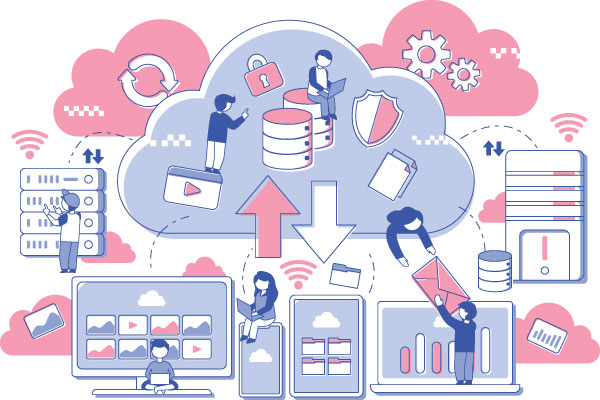
What is a Tech Stack in Application Development
In software and application development, a tech stack (also known as a software stack or development stack) is essentially the toolbox of technologies used to build a software application or system. It’s like the layers of ingredients in a cake, working together to create the final product.
Tech Stack in Application Development – Simple Terms
Here’s how you can think of it
- Think of layers: A tech stack typically has different layers, often categorized into front-end (user interface), back-end (server-side), and database. Each layer uses specific technologies for its purpose.
- Building blocks: Each layer uses various building blocks like programming languages, frameworks, libraries, tools, and technologies. Imagine these as the individual ingredients in the cake mix.
- Working together: All these components work together seamlessly to make the application function. Just like how the cake batter needs all the ingredients to rise and bake properly.
Key Components of a Tech Stack in Application Development
Front-end (Client-side)
This is what users see and interact with, like the website or app interface. Some popular front-end technologies include HTML, CSS, JavaScript, and frameworks like React or Vue.js.
Back-end (Server-side)
This is the “behind the scenes” part that handles application logic, data processing, and communication with the database. Examples of back-end technologies include programming languages like Python, Java, PHP, and frameworks like Django or Spring.
Database
This stores all the application’s data, such as user information, product details, or transaction history. Popular database options include relational databases like MySQL or PostgreSQL, and non-relational databases like MongoDB.
Middleware
This is the software that bridges the gap between the front-end and back-end systems, often handling tasks like data management, API services, and custom business logic.
Development Environments and Tools
These include integrated development environments (IDEs), version control systems like Git, and other tools like Docker for containerization, Jenkins for continuous integration/continuous deployment (CI/CD), and various testing tools.
Infrastructure
This includes the hardware and OS on which the application runs, along with cloud services (like AWS, Google Cloud, or Azure) and web servers (like Apache or Nginx).
Choosing the Right Tech Stack in Application Development
 The choice of technologies in a tech stack depends on the specific needs of the project, such as scalability, performance, and the development team’s expertise. Different types of projects may require different tech stacks.
The choice of technologies in a tech stack depends on the specific needs of the project, such as scalability, performance, and the development team’s expertise. Different types of projects may require different tech stacks.
- Application Type: What kind of application are you building? Different applications have different needs, so the ideal tech stack will vary.
- Team Expertise: Consider the skills and experience of your development team. Choose technologies they’re comfortable with to ensure efficient development.
- Scalability and Performance: Think about how the application needs to grow and perform in the future. Choose technologies that can handle increasing user traffic and data volume.
Some Examples of Popular Tech Stacks
- LAMP Stack: Linux, Apache, MySQL, PHP (used for many websites)
- MEAN Stack: MongoDB, Express.js, AngularJS, Node.js (used for modern web applications)
- MERN Stack: MongoDB, Express.js, ReactJS, Node.js (another popular web application stack)
Tech Stack for a New SAAS Application
Here are some recommended tech stacks for building a new SaaS application in 2024, considering current trends and best practices:
New SAAS – Front-End
- React: Highly popular and adaptable for building complex UIs, offers strong performance and a vast ecosystem of components and libraries.
- Vue.js: Lightweight and performant, ideal for smaller teams or those seeking a less opinionated framework.
- Angular: Comprehensive framework backed by Google, well-suited for large-scale applications with a structured approach.
New SAAS – Back-End
- Python/Django: A versatile and efficient language with a robust framework for rapid development and clean code organization.
- Node.js/Express: JavaScript runtime environment enabling full-stack development, promotes real-time features and efficient data handling.
- Java/Spring Boot: Mature and reliable language with a comprehensive framework for enterprise-grade applications, offering strong support and security.
New SAAS – Database
 PostgreSQL: Powerful relational database with advanced features for scalability, data integrity, and customization.
PostgreSQL: Powerful relational database with advanced features for scalability, data integrity, and customization.- MySQL: Widely used open-source relational database, easy to set up and manage, suitable for various use cases.
- MongoDB: Document-oriented database well-suited for flexible data structures and rapid development, often favored in modern SaaS applications.
New SAAS – Additional Considerations
- Scalability: Ensure technologies can handle increasing user load and data volume seamlessly. Consider cloud-native architectures for optimal flexibility.
- Deployment: Choose cloud platforms like AWS, Google Cloud Platform, or Azure for infrastructure and services, simplifying deployment and management.
- Security: Prioritize technologies with robust security features and best practices to protect user data and application integrity.
- Maintenance: Select technologies with active communities, comprehensive documentation, and regular updates for ongoing support and maintenance.
New SAAS – Best Practices
- API-first development: Design for a robust API layer to enable seamless integrations and future-proof your application.
- Microservices architecture: Consider breaking down your application into smaller, independent services for improved scalability, maintainability, and fault tolerance.
- DevOps practices: Implement continuous integration and continuous delivery (CI/CD) pipelines for efficient development and deployment processes.
Remember
The optimal tech stack in application development depends on your application’s unique requirements, team expertise, and growth projections. Evaluate different options through prototyping and proof-of-concept projects to make informed decisions. Keep abreast of evolving technologies and trends to make adjustments as needed.

 PostgreSQL: Powerful relational database with advanced features for scalability, data integrity, and customization.
PostgreSQL: Powerful relational database with advanced features for scalability, data integrity, and customization.